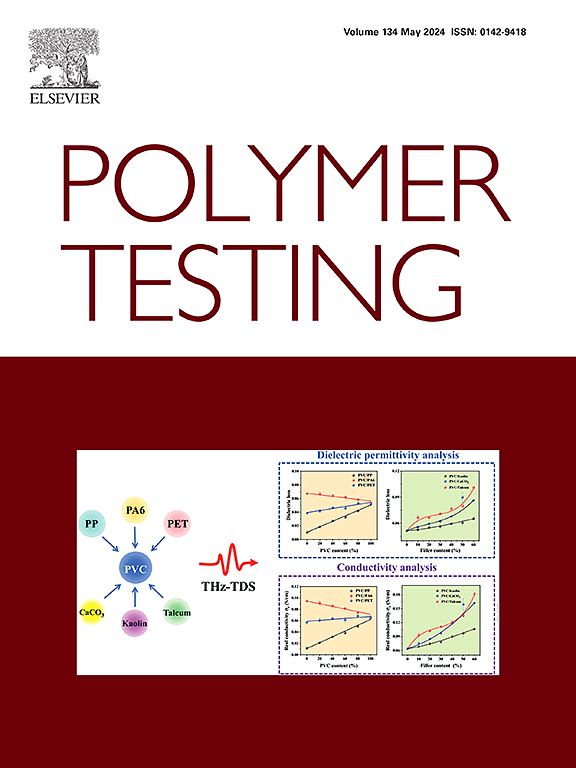Shedding light on the impact of a dissolution-precipitation recycling process on crystallization and thermal stability of PBS
IF 5
2区 材料科学
Q1 MATERIALS SCIENCE, CHARACTERIZATION & TESTING
引用次数: 0
Abstract
Poly(butylene succinate) (PBS) was recycled via dissolution/precipitation using Cyrene as a green solvent. The PBS recyclates were characterized by SEC, NMR, FTIR and TGA. The recycling process selectively removed the most polar chains and increased the proportion of shorter chains (lower Mn), as determined by size exclusion chromatography (SEC). Nuclear magnetic resonance (NMR) and infrared (IR) spectroscopy confirmed a reduction in -OH end groups alongside an increase in -CH3 end groups, indicating a slight decrease in polarity. This selective chain alteration significantly improved crystallization, as demonstrated by advanced kinetic analyses and Hoffman-Lauritzen (HL) theory. A lower energy barrier to nucleation (Kg) for recycled PBS (rPBS) highlighted an enhanced nucleation process, facilitating earlier crystallization during both heating and cooling, despite reduced diffusion. The recycled chains achieved favorable positioning more readily, influenced by entropic effects rather than the energetic barriers typically encountered during heating. This observation was further supported by higher pre-exponential term values in HL's equation for rPBS. Moreover, the pronounced crystallization differences during cooling were attributed to the low Kg values, emphasizing nucleation as the primary driving force. Ultimately, the formation of shorter chains and reduced polarity in rPBS were identified as key contributors to enhanced nucleation. Temperature-Modulated DSC (TOPEM) confirmed a structural heterogeneity inside the recycled sample. The thermal stability of both polymers was investigated, showing increased degradation at lower heating rates for rPBS, while being comparable to the fresh product at higher rates. Degradation mechanisms were studied using isoconversional kinetics, and showed major differences from 310 to 370 °C.

揭示了溶解-沉淀循环工艺对PBS结晶和热稳定性的影响
以聚琥珀酸丁二烯为绿色溶剂,采用溶解/沉淀法回收PBS。利用SEC、NMR、FTIR和TGA对回收物进行了表征。回收过程选择性地去除了大部分极性链,并增加了较短链(低Mn)的比例,这是通过尺寸排除色谱(SEC)确定的。核磁共振(NMR)和红外光谱(IR)证实了-OH端基的减少和-CH3端基的增加,表明极性略有下降。先进的动力学分析和Hoffman-Lauritzen (HL)理论证明,这种选择性链改变显著改善了结晶。再生PBS (rPBS)的成核能势垒(Kg)较低,突显了成核过程的增强,尽管扩散减少,但在加热和冷却过程中都能促进早期结晶。由于受到熵效应的影响,而不是在加热过程中通常遇到的能量障碍,循环链更容易获得有利的定位。这一观察结果进一步得到了HL’s方程中较高的指数前项值的支持。此外,冷却过程中明显的结晶差异归因于低Kg值,强调成核是主要驱动力。最终,rPBS中较短链的形成和极性的降低被认为是增强成核的关键因素。温度调制DSC (TOPEM)证实了回收样品内部的结构不均匀性。研究了这两种聚合物的热稳定性,表明在较低的加热速率下,rPBS的降解率增加,而在较高的加热速率下,其降解率与新鲜产品相当。用等转化动力学研究了降解机理,发现在310℃至370℃之间存在较大差异。
本文章由计算机程序翻译,如有差异,请以英文原文为准。
求助全文
约1分钟内获得全文
求助全文
来源期刊

Polymer Testing
工程技术-材料科学:表征与测试
CiteScore
10.70
自引率
5.90%
发文量
328
审稿时长
44 days
期刊介绍:
Polymer Testing focuses on the testing, analysis and characterization of polymer materials, including both synthetic and natural or biobased polymers. Novel testing methods and the testing of novel polymeric materials in bulk, solution and dispersion is covered. In addition, we welcome the submission of the testing of polymeric materials for a wide range of applications and industrial products as well as nanoscale characterization.
The scope includes but is not limited to the following main topics:
Novel testing methods and Chemical analysis
• mechanical, thermal, electrical, chemical, imaging, spectroscopy, scattering and rheology
Physical properties and behaviour of novel polymer systems
• nanoscale properties, morphology, transport properties
Degradation and recycling of polymeric materials when combined with novel testing or characterization methods
• degradation, biodegradation, ageing and fire retardancy
Modelling and Simulation work will be only considered when it is linked to new or previously published experimental results.
 求助内容:
求助内容: 应助结果提醒方式:
应助结果提醒方式:


